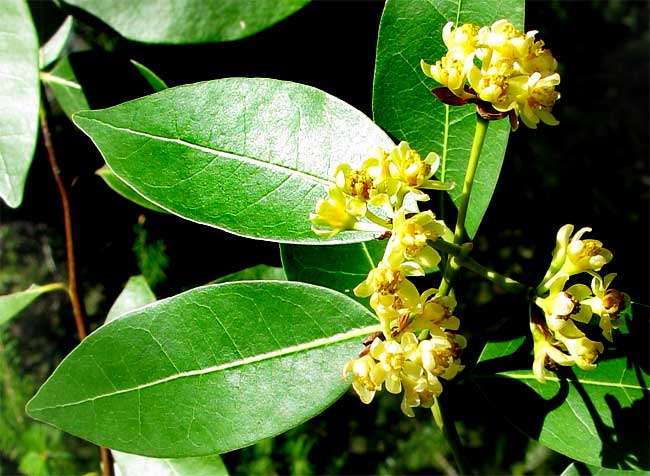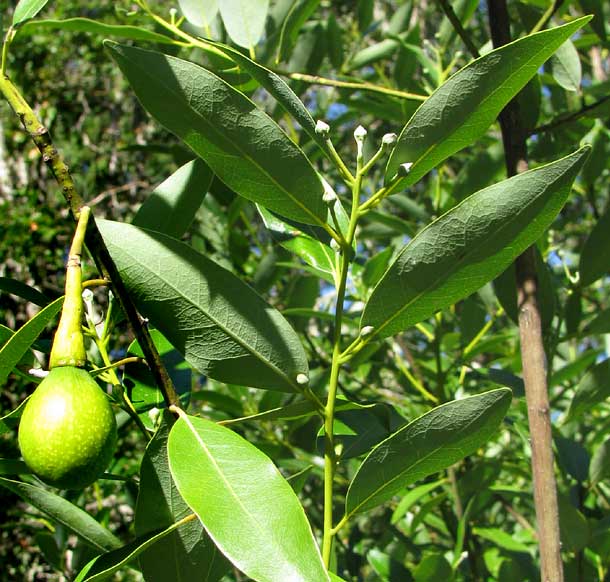Excerpts from Jim Conrad's
Naturalist Newsletter

from the the May 3, 2009 Newsletter, issued from the Siskiyou Mountains west of Grants Pass, Oregon:
CALIFORNIA-LAUREL LEAVES FOR STEWS
In mixed woods especially in valleys a conspicuously flowering tree this week has been the California-laurel, or Oregon-myrtle, UMBELLULARIA CALIFORNICA. See its shiny, evergreen leaves and yellow blossoms above.
Easterners might note the flowers' similarity to those of Sassafras, and there's a reason for that because they're in the same Family, the Laurel Family, or Lauraceae. The leaves' similarity to bay leaves used for seasoning also makes sense because the bay-leaf- producing tree similarly belongs to the Laurel Family. Likewise for the tropical Cinnamon-tree and Camphor-tree...
With such aromatic relatives it's not surprising that California-laurel leaves are very fragrant when you crush them, producing a pungent odor something like the mingling of the sweet-spicy smell of peppermint with menthol. In fact, when I first saw this tree I gathered a handful of leaves and seasoned my next morning campfire stew with them just as if they were store-bought bay leaves.
The resulting stew was delicious and the California-laurel's contribution was evident. However, it was funny: At first you think you're going to season all your stews with those leave but after one or two dishes you've had enough, and if you eat several servings you've had more than enough. Something in the leaves isn't conducive to repeated use. Though I still find the fresh leaves' odor delightful, I'm listening to my body on this and not cooking with them habitually as I might with real bay leaves.
from the October 4, 2009 Newsletter, issued from the Siskiyou Mountains west of Grants Pass, Oregon:
CALIFORNIA-LAUREL FRUITING
Now our California-Laurels are fruiting, as shown below:

The inch-long fruit, which technically is a drupe, turns yellowish green to purple when mature. The one in the picture is almost mature. Note the fruit's "cupule" (the enlarged fruit-stem) from which it dangles. Such cupules are common in the California-Laurel's family, the Laurel Family. Sassafras belongs to this family and you may remember that Sassafras fruits arise from similarly enlarged cupules. In the picture you can also see several silvery flower buds, which will open next spring.
Mature California-Laurel fruits can be eaten raw. The seeds are a bit bitter but when roasted or parched they lose their bitterness and can be eaten whole or ground into a powder from which bread can be made. Besides seasoning stews with the baylike leaves, a tea can be made from them. I read that the tree's root bark can be used as a coffee substitute; I'm guessing that it must be roasted and ground first. You might guess that such an aromatic plant must have had many traditional medicinal uses, and that's right -- so many that no particular ones stand out.
A superb article on how to prepare food from California-Laurel's vegetative parts and fruits is at http://www.paleotechnics.com/Articles/Bayarticle.html.